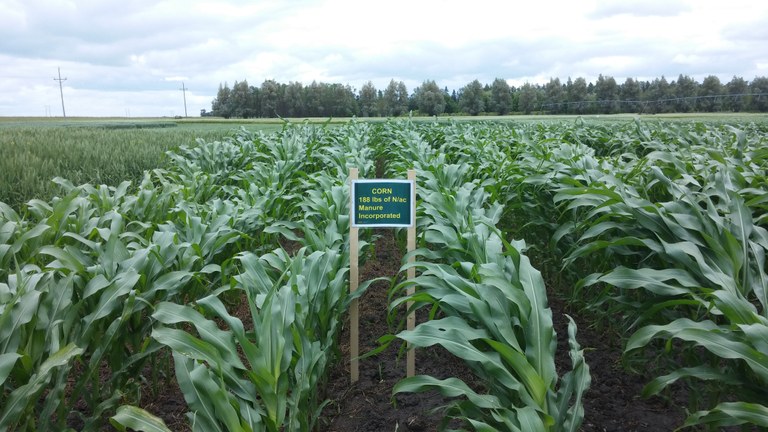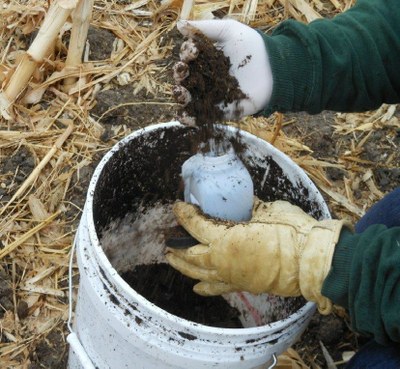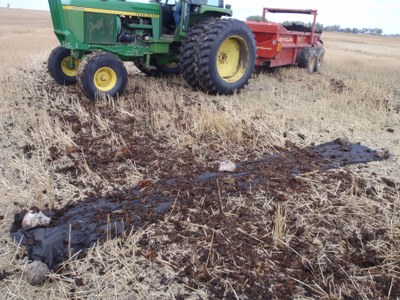Manure Spreader Calibration

Regardless of the lack of sunshine this summer, crops still grew and producers are working on getting kernels in the bin and bales hauled home before Mother Nature can inflict any(more) damage. Following harvest, it’s time to think about next year’s crops and fertilizer needs. While purchasing a load of commercial fertilizer is the easy option, I challenge you to consider long-term options for your crop and soil needs. Many beneficial and valuable plant nutrients, especially for corn, are contained in fresh livestock manures and compost. Besides the nutrients, using livestock manure or compost will add carbon back to the soil as well as improve water-holding capacity, bulk density and biological properties. I previously shared research using corn and manure on Center Points. That information can be found here: www.tinyurl.com/NDManureFertilizer.
 The first step in using manure/compost as fertilizer is to sample it for nutrient content. Sampling technique and area commercial laboratory information can be found here: http://www.ag.ndsu.edu/lem/resources/manure-nutrient-sampling-and-testing. Next, soil testing for nutrients is equally as important as testing manure. Information on soil sampling technique and reading your soil test results can be found in this video: http://tinyurl.com/soiltestingvideo. Having field crop history, manure and soil nutrient test results and future crop information will help you determine the amount of fertilizer (manure, compost and/or commercial) that needs to be applied. Using the 2 new calculators designed specifically for ND corn producers (ND Corn Nitrogen calculator found here: http://www.ndsu.edu/pubweb/soils/corn/ and the ND Manure Corn Nitrogen and Phosphorus calculator found here: http://www.ag.ndsu.edu/lem/manure-corn-n-p-calculator) will offer you some fertilizer guidelines to follow and assure that you are neither under- or over-applying fertilizer. Both can have detrimental effects, be it on the checkbook or environment.
The first step in using manure/compost as fertilizer is to sample it for nutrient content. Sampling technique and area commercial laboratory information can be found here: http://www.ag.ndsu.edu/lem/resources/manure-nutrient-sampling-and-testing. Next, soil testing for nutrients is equally as important as testing manure. Information on soil sampling technique and reading your soil test results can be found in this video: http://tinyurl.com/soiltestingvideo. Having field crop history, manure and soil nutrient test results and future crop information will help you determine the amount of fertilizer (manure, compost and/or commercial) that needs to be applied. Using the 2 new calculators designed specifically for ND corn producers (ND Corn Nitrogen calculator found here: http://www.ndsu.edu/pubweb/soils/corn/ and the ND Manure Corn Nitrogen and Phosphorus calculator found here: http://www.ag.ndsu.edu/lem/manure-corn-n-p-calculator) will offer you some fertilizer guidelines to follow and assure that you are neither under- or over-applying fertilizer. Both can have detrimental effects, be it on the checkbook or environment.

Now that you know how much manure/compost to apply, it is time to calibrate the spreader. Calibrating the manure spreader is a simple process and can be done with items that are most likely already present on the farm. An explanation of 2 manure spreader calibration techniques with easy-to-follow worksheets can be found here: http://tinyurl.com/manurespreadercalibration. The following steps highlight how to calibrate a manure spreader using the sheet method. This method can be done with your personal spreader or a custom spreader.
- Materials:
- Sheet or tarp that measures 21.8 feet2 (you can use any tarp, you just need to know its area (length ft x width ft))
- 5-gallon bucket
- Scale
- Weigh the bucket and sheet to tare the weight of the manure.
- Lay out the sheet and anchor it down with a few rocks or stakes.
- Record your tractor gear, engine’s revolutions per minute (RPM) and spreader settings.
- Apply the manure over the sheet.
- Weigh the manure-covered sheet in the bucket.
- If the tarp measures 21.8 ft2, the weight in pounds of manure on the sheet is equal to tons/acre. If not, simply multiply the bucket weight by 21.8 and divide that by the tarp area in square feet (ft2).
- Do this 3 times or set up 3 separate sheets and use an average of the weights.
I would like to help 5 crop producers and/or custom manure haulers calibrate their manure spreaders this fall. If you would like help calibrating a manure spreader please contact me at 701-652-2951 or mary.berg@ndsu.edu.
Mary Berg
Livestock Environmental Management Specialist


